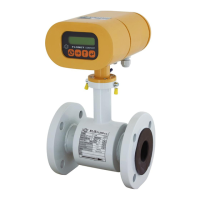ELIS PLZEŇ a. s., Luční 425/15, 301 00 Plzeň, Czech Republic, Phone: +420/377 517 711, Fax: +420/377 517 722 Es90420K/c
Make sure that the adjoining piping is clamped/supported as close to the sensor as possible, to prevent
vibrations and damage to the sensor.
Undesirable sensor vibrations Sensor bypass
In applications where continuous liquid flow is essential, a bypass shall be provided to allow for sensor
servicing. A sensor bypass may also be a reasonable solution where dismantling the flow sensor would
require an emptying of a very long section of piping.
5.2. Sensor grounding
The correct meter function requires that both sensor and adjoining piping sections are duly interconnected to
the ground potential by low-impedance grounding conductors and a protective conductor from a power
supply. The overall arrangement shall be such that the potentials of the measured liquid at the sensor inlet
and outlet sides are close to the ground.
With a flanged sensor installed in electrically conductive piping, the flanges shall be electrically connected
with the piping and the piping connected to earth.
Flange grounding connection Grounding rings
Should the adjoining piping sections be non-conductive, grounding rings or similar instruments shall be used
to ensure that the electric potential of the measured liquid is properly grounded.
In case of a flangeless sensor, the piping flanges holding the sensor shall be electrically connected with the
grounding point on the sensor.
Flangeless sensor
To ensure potential equalisation for remote version of
flowmeter, it is recommended to interconnect the sensor
body with the transmitter housing with a copper
conductor of cross-section 4mm
2
.

